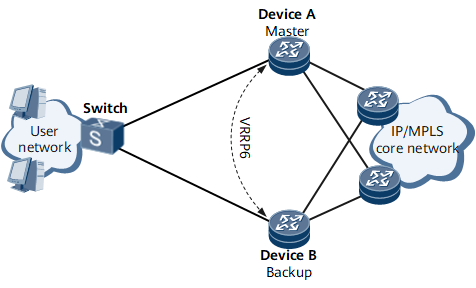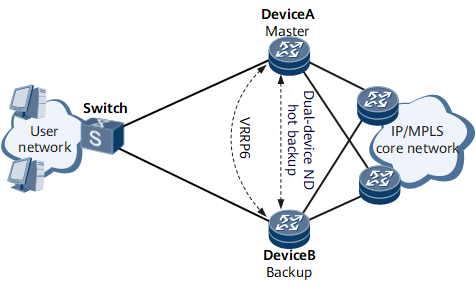Dual-Device ND Hot Backup
Networking Description
Dual-device ND hot backup enables the master device to back up ND entries at the control and forwarding layers to the backup device in real time. When the backup device switches to a master device, it uses the backup ND entries to generate host route information. After you deploy dual-device ND hot backup, once a master/backup VRRP6 switchover occurs, the new master device forwards downlink traffic with no need for relearning ND entries. Dual-device ND hot backup ensures downstream traffic continuity.
Figure 1 shows a typical network topology in which a VRRP6 backup group is deployed. In the topology, Device A is a master device, and Device B is a backup device. In normal circumstances, Device A forwards both upstream and downstream traffic. If Device A or the link between Device A and the switch fails, a master/backup VRRP6 switchover is triggered and Device B becomes the master device. Then, Device B needs to advertise network segment routes to devices on the network side so that downstream traffic is directed from the network side to Device B. If Device B has not learned ND entries from user-side devices, the downstream traffic is interrupted. Therefore, downstream traffic can be properly forwarded only after Device B is deployed with ND dual-device hot backup and learns ND entries of user-side devices.

In addition to a master/backup VRRP6 switchover, a master/backup E-Trunk switchover also triggers this problem. Therefore, dual-device ND hot backup also applies to E-Trunk master/backup scenarios. This section describes the implementation of dual-device ND hot backup in VRRP6 scenarios.
Feature Deployment
If Device A or the link between Device A and the switch fails, a master/backup VRRP6 switchover is triggered and Device B becomes the master device. Device B advertises network segment routes to network-side devices and downstream traffic is directed to Device B.
- Before you deploy dual-device ND hot backup, Device B does not learn the ND entry of a user-side device and therefore a large number of ND Miss messages are transmitted. As a result, system resources are consumed and downstream traffic is interrupted.
- After you deploy dual-device ND hot backup, Device B backs up ND information on Device A in real time. When Device B receives downstream traffic, it forwards the downstream traffic based on the backup ND information.

